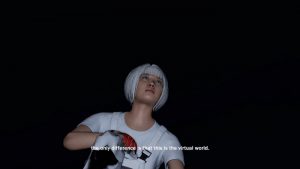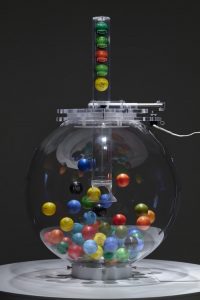When in 1985 Robert Zemeckis created his film Back to the Future I, he injected an idea into mainstream, visual culture, which wasn’t at all new to those familiar with science fiction since Orson Wells’ Time Machine. Namely, that time is not necessarily a linear thing as Hegel believed, maybe even linked to something like destiny, but that it might be a quite volatile network of causalities that could be messed with in the presence of a speculative device like a time-machine, in this case a beautiful DeLorean sports car.
Today we’re much more accustomed to this kind of storytelling device, most recently in J.J. Adams’ Star Trek in which the two Spocks even make fun of the notion of the temporal paradox which is one of the motifs of the original Back to the Future.
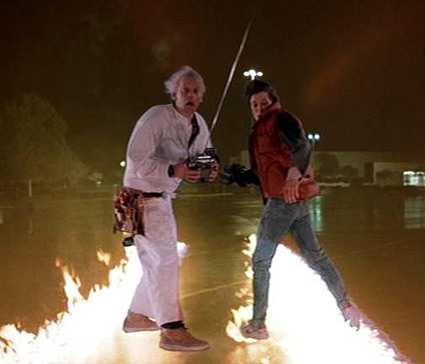 Back to the Future I, © Universal Studios
Back to the Future I, © Universal Studios
However, outside of science fiction narratives, audiences still appear to be having a hard time with speculation about different pasts and futures. Or maybe it is not like that at all. Theoretical physics is obviously very invested in the notion of multiple universes and remarkably the financial industry as well, as speculation and insurance are trades which are purely about the future. And there is speculative design, most visibly represented by Dunne & Raby and Design Interactions at the RCA in London, which in turn is linked to scenario techniques that stem from the Cold War and places like RAND Corporation.
When I was in Berlin recently, I had the chance to see a distinct small show of the same title at COMA, curated by PROGRAM’s Carson Chan.
Chan goes a step further and in the text that accompanies the exhibition suggests that the whole Western world has seemingly been infected by this notion of a non-linear destiny which can, or must be shaped. Famously, in his metaphysical reasoning for war, Donald Rumsfeld has been the most recent one to “expose a world in which science fiction and reality collide to bewildering effect” when he was going on about known unknowns: “There are known knowns. These are things we know that we know. There are known unknowns. That is to say, there are things that we know we don’t know. But there are also unknown unknowns. There are things we don’t know we don’t know”
The show Back to the Future explores the role of art in this conundrum. It is a selection of artistic time machines which, each in very different ways, are attempting to “allow time, history and causality to be continually renewed”. A few favorites:
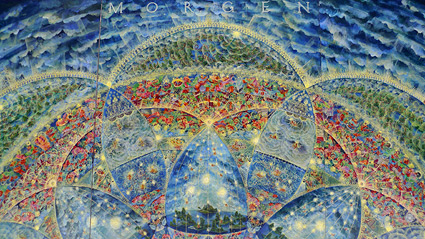 Morgen, Michel Kunze
Morgen, Michel Kunze
The first thing to see is a huge, colorful painting by Michel Kunze titled Morgen which, by referring to the tradition of the Mandala hints at the representation of time as an almost endless circle of reincarnations. A much more worldly take on the subject is Ignacio Uriarte‘s 60 seconds, a circle of sixty classic Casio watches which are all linked by their wristbands.
At the day of the opening, the watches were set to exactly the same time, albeit being each one second faster than the watch before and slower than the next one respectively. One can step inside the installation and be inside one minute, so to speak, and it is also reminiscent of time-zones and their artificial nature. Since the Casios have their characteristic hourly beep-beep switched on, the piece becomes a sound-sculpture each hour, with the minute literally moving around the person who is in the center. However, over the time-span of the exhibition the deliberate asynchronicity between the watches had already deteriorated to the point where I initially perceived it as randomness, exposing the fact that an artifact we regard as fairly precise actually is not.
 60 seconds, Ignacio Uriarte
60 seconds, Ignacio Uriarte
Jeremy Shaw showed a video piece which focuses exactly on the initially mentioned visual culture of science fiction. His This Transition Will Never End #2 is an edit of a great number of time and space travel sequences from movies over the decades. It’s an endless jump which effortlessly reveals the visual language around something that does not exist yet has arrived at its place in popular imagination.
Oliver Laric’s piece Versions, of which you can watch different versions, stands conceptually at the center of the topic of the show as Carson was explaining. It looks at recent examples of popular memes and how the idea of authorship and the notion of the original is being obliterated before our eyes. What used to be news, evidence or entertainment is all becoming parts of a complex network of interconnections between senders and recipients of information.
On the example of an image, like Iran’s infamous photoshopped missiles, Versions talks about in the beginning, gets created and manipulated, then distributed. However, this only triggers another burst of anonymously authored image manipulation in which many additional versions are being created and also distributed. But, and this is the interesting part, what comes closest to the old notion of the real image will often be determined by the fact which one shows up on top on Google, mainly linked to its popularity. And this, to make it even more complex will also change over time. Welcome to the visual world of Rumsfeldian logic where known knowns are in fact long gone.
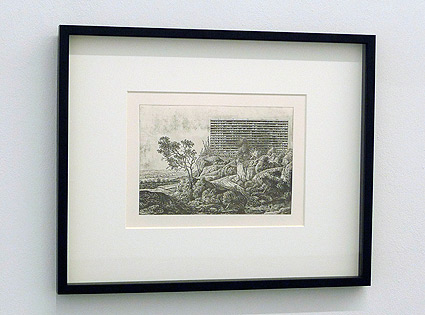 Belief in the Age of Disbelief, Cyprien Gaillard
Belief in the Age of Disbelief, Cyprien Gaillard
Cyprien Gaillard’s Belief in the Age of Disbelief is a series of 17th Century Dutch landscape etchings in which modernist buildings have been inserted to form an uncannily, almost romantic whole. The architecture, which was once the subject of idealistic visions of the future by the likes of Le Corbusier, has obviously undergone great changes in the way it has been perceived in the past, with a recent wave of appreciation for buildings such as Trellick Tower in London. Nature one could argue, is undergoing the same shifts in perception, although on a much longer time frame, rendering the combination of both quite peculiar as they could be pictures from a utopian future as well as reclaimed ruins from an age gone by.
A favorite was Warren Neidlich’s The Battle of Chicamauga, which belongs to his five-part alternate history series (1986-2001) American History Reinvented. The exhibited piece consists of a number of faded historical aerial photographs of the battle of the same name that took place 1863 in the state of Georgia during the American civil war. The little thing that does not make sense, however, is the fact that at the time there were no airplanes, because the first manned flight had only taken place on December 17th 1903.
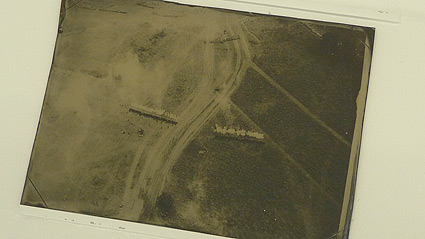 The Battle of Chicamauga, Warren Neidlich
The Battle of Chicamauga, Warren Neidlich
In truth, the photographs were taken from a rented plane during a present-day reenactment of the battle, something that according to Neidlich is a favorite past-time for many Americans. He had the photo developed and then went back to the reenactment in order to have the modern prints reproduced as tintypes, the state-of-the-art technology at the time which has become very rare today. The “webs of contradictions” in this and other pieces from the series ask the question of what the past would have been like “if the news media of today, with all their intrusive glitz and certitude, had been around when some of the most important events in American history took place” hinting at that all history has always been technological mediated.
More photos.
Related: Carson Chan at DLD, The Golden Institute, History Will Repeat Itself


